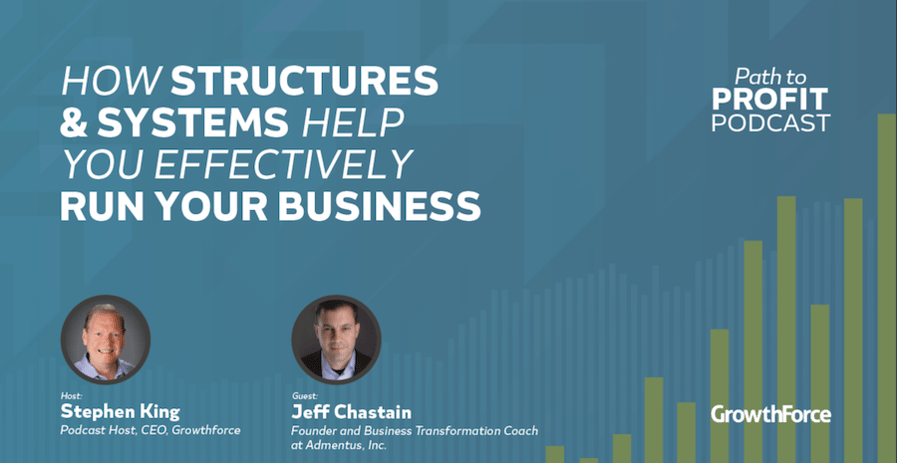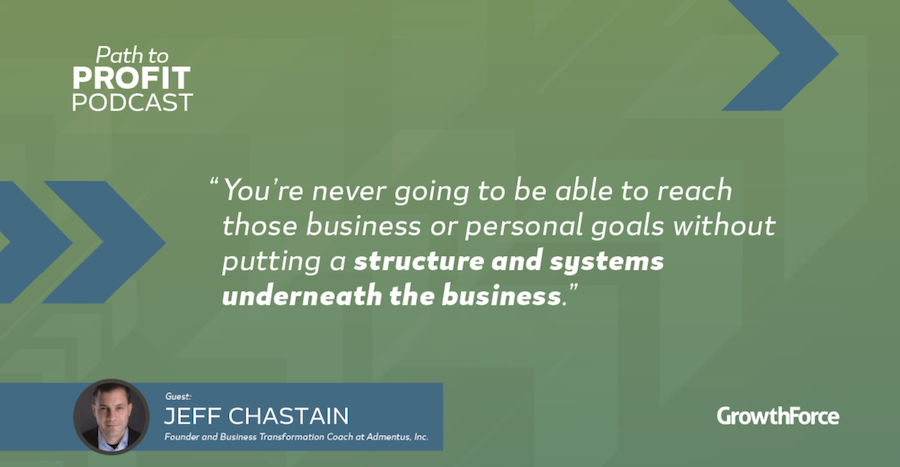7 min read

If an aspiring business owner decides to purchase a franchise, they open for business with a complete corporate handbook on how best to run and build the business.
|
Key Takeaways
|
This handbook outlines everything from daily operations and hiring employees to marketing, financial benchmarks, and setting monthly goals.
When an entrepreneur strikes out on their own to start a business from scratch, they don’t have a playbook. They don’t have anything to tell them how best to operate, make decisions, set goals, and measure success. As a result, many entrepreneurs make costly mistakes at a time when cash is limited and their own time is often stretched to the max.
🎧 Don’t miss an episode! Subscribe & listen to more insightful conversations here!
GrowthForce Founder and CEO, Stephen King sat and talked with Jeff Chastain, Founder and Business Transformation Coach at Admentus, Inc, to discuss the playbook and pillars he uses when consulting new business owners on how best to get their businesses up and operating in the direction of success.
Throwing Darts vs. Using Entrepreneurial Operating System (EOS)
Although Chastain has been in the consulting game for about 15 years now, his background is an entrepreneur who made his share of mistakes while operating a startup.
Operating any business- let alone a newer business coming out of the delicate startup phase- is risky without a solid game plan and playbook that can help new business owners strategize, set goals, and make data-driven decisions to help you lead your business in the right direction.
Chastain compares operating without a playbook to throwing darts, essentially, tossing ideas against a wall and seeing what sticks. In business, the only thing that a non-strategy like this one is good for is wasting money.
Chastain describes his company and principles as “system agnostic,” meaning his business does not ascribe to a single vision-traction organizing system.
The Entrepreneurial Operating System (EOS), as created and defined by Gino Wickman, can provide a good option for new or existing business owners that don’t want to start from scratch when it comes to the process of getting their companies on track.
One of the main reasons why many growing organizations look towards EOS as an operating framework is because it solves one of business leaders’ biggest pains: lack of processes. Organizations in this stage often struggle with nailing down formal processes that will help scale their business.
If you want to set long-term and short-term goals, streamline operations, orient your whole company around a common vision, and start marching toward success, then EOS can help you stop throwing darts and wasting money and start setting meaningful goals, making data-based decisions, and increasing your ROI.
The 4 Pillars for Business Success
Chastain’s playbook for successful business outlines 4 pillars that every business owner needs to pay close attention to and make sure they get right to make the most of their working capital, achieve profitability, and grow their businesses.
1. People
Chastain shared a story about one of the mistakes he made early in a company he started, and that was hiring a salesperson to lead the sales department without knowing how to hire the right kind of salesperson for his company and without knowing what that person’s job description, goals, or strategy would be. They simply hired a person, asked them to design their own job, and paid him month over month without results.
“Payroll,” Chastain noted, “is always one of the biggest expenditures in any kind of company, so if you’re going to put those resources on payroll, make sure you get it right.”
In service-based businesses, this statement is even more accurate since your people are your product.
Unfortunately, like the mistake Chastain made in his business, many business owners attempt to hire without a good human capital management strategy that not only outlines specific job descriptions but also includes a hiring plan designed to hire the right people for the right roles in your business.
A big part of getting hiring right in a company is defining culture. As Chastain describes, a green energy company probably shouldn’t hire someone who has worked their entire life in oil companies – unless, of course, a person with a background in a competing industry is really something you need. If that’s the case, make sure that their values align with those of your company.
Read More: Common Human Capital Strategy Mistakes & How You Can Avoid Them
Consider what it is that your company really values and what it is that you value in your employees. Is it their experience, background, attitude, work ethic, or something else?
Hiring the right person for a job not only prevents you from wasting money on payroll while you learn that the wrong person was not a good fit, but it also saves you from paying the high cost of turnover as a result of bad hiring practices.
2. Purpose
Purpose is essential to business. Yes, you want to make money and be successful, but actually defining how you plan to make money and defining what success is in your business is essential to achieving it – both company-wide and at the level of the individual employee.
Setting your company’s purpose, communicating it throughout the company, and orienting every department and employee around the same purpose is essential to success. A business owner must first set goals (i.e. defining purpose and success), but then the business owner must also determine a strategy for achieving that success and communicate it clearly to their employees.
This means identifying non-competing goals to assign each department in the company and clearly outlining benchmarks for individual employees.
At the end of the year, quarter, or whenever you conduct employee reviews, there should be a clear, data-based way to determine whether or not each person in your company was successful and to measure how successful they were against the benchmarks that were set for them.

3. Playbook
Every business owner – especially those running new companies – need to have a playbook for how they are going to spend their time and delegate their responsibilities.
Too often, business owners attempt to wear all of the hats; they work on drumming up sales leads, they provide services, they handle the finances, they clean the office, etc.
Hint: Your Operating System should lay the foundation for your playbook!
Business owners need a plan to track and evaluate exactly how they are spending their time in order to identify the highest-value responsibilities. Then, they should trust their hiring plan, to first delegate the responsibilities that they either don’t know well or don’t enjoy to other individuals in their company who are a good fit for handling those tasks.
Read More: Why The Most Successful Businesses Run On Operating Frameworks
4. Performance
Finally, it all comes down to performance and having the ability to identify and track both leading indicators and your success metrics. Success metrics help you set goals in your company, which could be something like achieving a certain profit margin by the end of the year. On the other hand, leading indicators help you forecast performance to avoid pitfalls and better plan for the future.
Performance tracking means looking at the metrics that help you identify when you’ve achieved your goals while also identifying leading indicators that can act as an early warning sign of an upcoming cash flow shortage or operational lag.
These metrics differ depending on your specific goals and your industry. For some, however, leading indicators might start with looking at sales leads and time to close/collect payment. If, for example, you have a three-month-long sales cycle, then fewer leads could be a leading indicator of a cash flow shortage in three months.
Supporting Strategy With the Right Systems
When implementing these business pillars or a system like EOS, it’s essential that you have the tools, technology, and systems in place to help support setting goals, communicating goals, tracking metrics, and developing and revising strategies to achieve those goals.
To improve your leadership, decision-making, operations, and business strategy, it’s essential to automate as many manual processes as possible, especially when it comes to your business’s back office. Automating processes saves you time and money, and ensures you always have timely and accurate financial data available at your fingertips.


